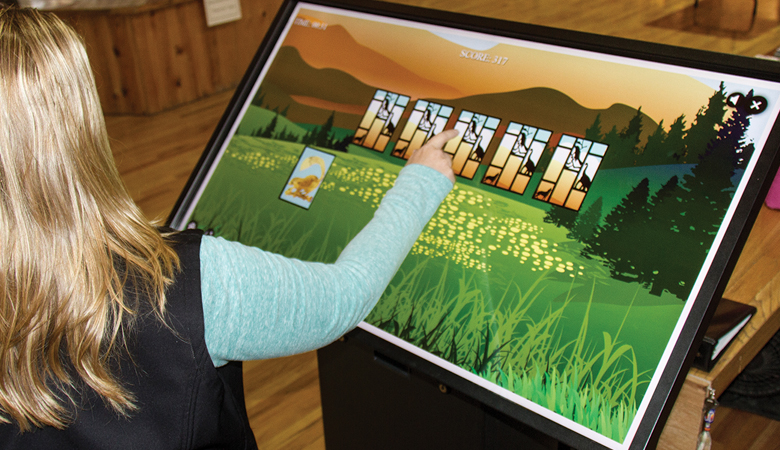Uncovering Digital Signage Opportunities
Above: Toshiba interactive digital signage deployed at Crazy Horse Memorial in South Dakota. Photo courtesy of Crazy Horse Memorial Foundation.
Big-ticket live entertainment is always looking for new ways to engage fans and provide an epic, immersive experience that can’t be replicated in the living room. This past summer, Toshiba announced a new, multimillion-dollar partnership with live entertainment powerhouse AEG. In addition to serving as the official copier and multifunction printer supplier for AEG properties nationwide, including music festivals, Toshiba is a founding partner of the Staples Center, home of Los Angeles’s NBA and WNBA teams as well as the NHL Kings.
At Dignity Health Sports Park in Carson, California, the scale of Toshiba and AEG’s partnership is fully on display. Though digital scoreboards have been getting larger, more information-dense, and visually captivating for years, every time LA Galaxy superstar Zlatan Ibrahimovic smashes a soccer ball past an unsuspecting goalkeeper his efforts are recorded on a 53-foot-wide ultra-HD Toshiba scoreboard on one side of the stadium and a 125-foot-wide LED on the other side, the largest in Major League Soccer.
Size and definition are the never-ending arms races of digital displays. But the real innovation is where Toshiba breaks outside the confines of a standard rectangular screen, with the four-foot-wide digital ribbon that runs along the stadium’s upper deck. The 8,688 lines of full-color resolution not only display highlights, player statistics, and out-of-town scores but also dynamically react to the events on the field. Every time there’s a goal or a great play, all 27,000 fans are treated to a light show that transforms the entire stadium into an experience more like a concert or even virtual reality, breaking the boundaries between what’s on the field and what’s on the screen. A goal no longer just changes a number on a static scoreboard. It changes the entire look and feel of the game.
While the average office park probably won’t find a need for ribbon boards any time soon, seeing one in person makes it hard not to ask why not? When information in all fields changes so quickly, it’s hard to understand why static information displays are still in wide use.
Corporate communication and document management have been moving steadily in a digital and cloud-based direction for over a decade, which makes digital displays the next logical step for providing human interfaces to content that’s already dynamically updated and distributed in real-time.
Don Dempsey, major account sales manager at LDI Color Toolbox, is on the front lines of this technological revolution. LDI Color Toolbox sells digital displays from Samsung, as well as big-screen commercial LED smart HD TVs from Sharp.
“Today’s consumer is more inclined to notice a multimedia message versus a static image,” Dempsey said. “Digital signage further enables interactive communication, thereby presenting a more personalized experience for our clients and their stakeholders.”
Digital signage can give retail businesses an advantage, not only in attracting attention but also in improving responses to changing demands.
Tyson Stargel, vice president of Star Managed Services, a division of Stargel Office Solutions in Houston, Texas, worked with the Houston Astros to implement digital concession signage that took advantage of the technology’s ability to display high-resolution food photography and animated transitions to attract attention, and to connect to the point-of-sale system to track sales and shape customer behavior.
“So, if hot dogs [inventory] got low, the price of the hot dog would go up, but the price of a hamburger would go down,” said Stargel. “They might have a ball flying around the menu with the prices, and flying around the hamburgers a bit more, to catch people’s attention.”
The result: No more risk of disappointing customers with inventory shortages. When the supply changed, digital displays changed the demand.
This isn’t just tech for the sports park, though. As digital displays become more streamlined, energy-efficient, and user-friendly, offices are finding new ways to meet their internal communication needs as well.
Office and Vertical Applications
“There is an increasing trend to use video conferencing so teams can collaborate in real-time,” said Dempsey. “Digital signage facilitates more effective communication among coworkers. It does so by allowing for a more personalized collaborative experience by seeing each other on the digital signage.”
Gary Bailer, director of product management at Sharp Electronics Corp., sees millennials as the driving force in adopting interactive tech, whether it’s the company’s Aquos products or its new Windows Collaboration Display, introduced at its recent dealer meeting in Las Vegas.
“We have an entirely new type of constituent in the workforce that is used to collaborating in real-time wherever they might be and whatever they might be doing,” said Bailer. “The idea of utilizing our Aquos Board family of products and similar types of technologies in a unified communications organization is growing by leaps and bounds.”
This kind of connectivity only becomes more important as remote workers make up larger shares of the workforce. As tech-savvy millennials move into their prime career years, corporate IT teams are less concerned that attempts to adopt more complex technology is hindered by users’ apprehension. Everyone carries a smart screen around with them in their pockets now, and being able to connect quickly and reliably with displays in the office makes for better communication and frustration-free presentations.
“With the millennials continuing to represent a significant share of the workforce, we are seeing more and more companies interested in adopting digital signage for varying applications,” said Dempsey.
It’s important to remember that communication doesn’t just happen in the boardroom. One of Dempsey’s clients, an insurance company, deployed dual 60-inch digital displays in its call center with three dynamically updating “channels” in full view of the whole team. One channel displays vital productivity statistics like the number of calls on hold-–information taken directly from a connection to the company’s Avaya phone system–while the other channels display company news such as birthdays and anniversaries, general news, and weather. Call centers are famously high-stress workplaces, but having a shared information source not only helps keep everyone on track but also keeps them connected as a team.
Stargel’s team installed digital displays in another high-stress environment, a hospital. One of the most frustrating and little-discussed aspects of large medical facilities is how challenging wayfinding can be. A maze of identical-looking corridors filled with medical staffers rushing about with no time to offer directions can be confusing for patients and visiting doctors alike. Stargel worked with Toshiba to design a system of interactive signage that was accurate, up-to-date, and most importantly, eye-catching.
For a dealer just entering the digital display side of the business, most sales will be with existing clients, so that means a painless installation process is vital. Depending on the complexity, it can make sense to tell clients to expect a little extra time compared to installations for more traditional equipment, and both dealers and clients should take full advantage of the resources digital-display manufacturers provide.
“It was nice that Toshiba had been researching for a while,” said Stargel. “They’d kicked off the program with their direct dealers, and after they had launched it and been successful with their clients, they came to the dealers. The more experience you can piggyback off of, the better.”
Digital Signage Sales Tips
A deep rapport with clients is essential for selling digital signage. When the right tool to solve a problem doesn’t exist yet, that problem gets pushed on a back burner. Now that digital displays are hitting the mainstream, conversations with clients may uncover opportunities they hadn’t thought of themselves. Dealers can be asking what kind of information their customers want to share with employees, clients, and guests; what information is being missed when it’s delivered through traditional channels such as email or static, printed signs; what methods are employees using to share information right now; and how much meeting time wasted troubleshooting those methods or finding the right cable to plug in.
Most importantly, dealers should try to gain an understanding of how the tech environment of the workspace aligns with employee expectations. The workplace was once where average Americans encountered cutting-edge technology first, but now the office often lags far behind the consumer space.
“It used to be thought of with interactive displays that the primary market would be the K-12 education sector,” said Bailer. “It certainly is, but that group of people who grew up with interactive displays in school, all the way through college, they go out into the workforce and expect the technology to be there. ‘My laptop can do this. Can’t you do this in a conference room too?’ They expect to be able to seamlessly transfer what they do on the small screen, from one environment to the next, picking up where they left off. That technology is there and easy to implement these days.”
Access Related Content
Visit the www.thecannatareport.com. To become a subscriber, visit www.thecannatareport.com/register or contact cjcannata@cannatareport.com directly. Bulk subscription rates are also available.




